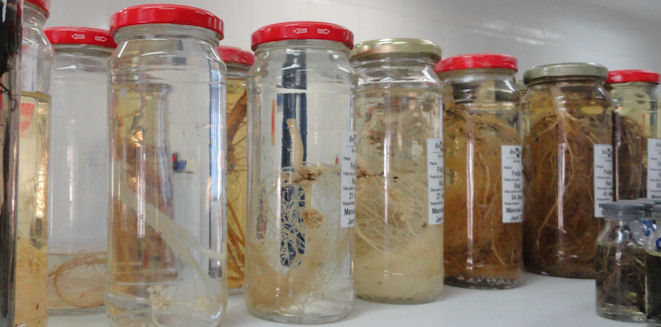
I got to visit Embrapa in Boa Vista. This was a treat for me. Embrapa is the Brazilian version of USDA. I enjoy visits at science labs and among them the agricultural ones are my favorites. Some people think that agriculture is something from the past. In fact, it is one of the most future oriented industries there is. IMO, someday soon when people use the term high-tech, they will more often be referring to biological systems rather than computers, i.e. mostly agricultural based.
In one of labs they were studying plant pests and diseases. The showed me a leaf that was clearly unhealthy. Only under the microscope could you see really small red spiders that were creating the problem. The scientists were testing another kind of bug that eats the spiders. The “good” bugs were native to Brazil, but usually not present in sufficient numbers to control outbreaks. You could introduce them in numbers to kill off the spiders. When the spider population dropped, so would the predators. They would never wipe out all the spiders, but there would be equilibrium. If spider population went up, the predator population would follow. The key to joy is NOT totally defeating the spider menace.
People worry about climate change, but maybe a more immediate threat is invasive species. You really cannot keep them out, but science can try to stay a step ahead. The spiders were invasive. Interestingly the predators were native that just needed a little help to fight back.
In another lab they were studying nitrogen fixing plants. Everybody knows that legumes can fix create their own nitrogen, but they don’t do it on their own. The nitrogen is fixed from the air by bacteria that form in nodes on the roots. I knew that, but didn’t think much about it. I thought that the bacteria just kind of came along. They don’t. The bacteria are present in the soils, but not always in numbers needed. This is a problem in Brazil more than in North America because the soils in tropical Brazil tend to have less organic material. It decays fast in the tropics and w/o the organic materials the bacteria dies off. So they can vastly increase the productivity of things like soybeans by spraying by applying the bacteria that fix nitrogen. It is cheaper than fertilizer. There can be a residual affect and the next crop planted, often corn, can take up the left over nitrogen. The challenge is that sometimes there is nitrogen enough but not other necessary elements such at phosphorus. This is didn’t know. Phosphorus can also be fixed by bacteria. In this case it doesn’t take it from the air, as in the case of nitrogen. Aluminum is present in many Brazilian soils and it binds with phosphorous, making the phosphorus unavailable for plants. Some bacteria can break the bonds and convert the phosphorus into a form usable by plants.
There are other very interesting advances involving fungus that helps plants extract water and nutrients from the soil. They had them in petri dishes in a refrigerator. I jokes that I am growing stuff like that at home too. Anyway, it is all very cool. I could have stayed much longer, but I had my next appointment.
Each location is unique and it is important to localize knowledge too. Roraima is a new location and a new frontier and there are lots of things to learn.
The picture up top shows various roots with nitrogen nodes on them.

I think those would be mites rather than spiders. Similar but not the same.
The major invasive species in the Americas is Homo sapiens. A very destructive animal, with few predators.
These called them something related to arachnids (in Portuguese.) They did not call them spiders, so you are probably right. I called them spiders because they looked like spiders.
Re Homo sapiens, the other animals don’t write blogs or do research, so we can call them invasive while they have no idea what is going on beyond their immediate experience.